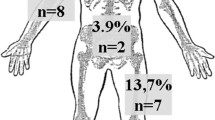Abstract
Background
Optimal duration of antibiotic prophylaxis following major lower limb amputation in preventing adverse stump outcomes is controversial.
Objective
We assess the epidemiology and risk factors of wound dehiscence and stump infection after mid-thigh to transmetatarsal amputations with regard to antibiotic administration.
Methods
Our retrospective observational study at the Geneva University Hospital (January 1995–June 2010) includes a total of 289 amputations in 270 adult patients (199 males; median age 70 years).
Results
Wound dehiscence and/or stump infection occurred in 47 (16.3 %) and 63 (21.8 %) patients with a median delay of 24 and 14 days, respectively. No clinical variable was significantly associated with stump infection. Diabetes and older age (>80 years) were associated with dehiscence. Importantly, transcutaneous tissue oxygen tension (TcPO2) and duration of antibiotic administration showed no association with either outcome.
Conclusion
The duration of antibiotic administration before or after surgery does not change the epidemiology of stump complications.

Similar content being viewed by others
References
Karakoç A, Ersoy RU, Arslan M, Toruner FB, Yetkin I. Change in amputation rate in a Turkish diabetic foot population. J Diabetes Complicat. 2004;18:169–72.
Assal JP, Golay A. Patient education in Switzerland: from diabetes to chronic diseases. Patient Educ Couns. 2001;44:65–9.
Stone PA, Flaherty SK, Aburahma AF, Hass SM, Jackson JM, Hayes JD, Hofeldt MJ, Hager CS, Elmore MS. Factors affecting perioperative mortality and wound-related complications following major lower extremity amputations. Ann Vasc Surg. 2006;20:209–16.
Pollard J, Hamilton GA, Rush SM, Ford LA. Mortality and morbidity after transmetatarsal amputation: retrospective review of 101 cases. J Foot Ankle Surg. 2006;45:91–7.
Carmona GA, Lacraz A, Assal M. Walking activity in prosthesis-bearing lower-limb amputees. Rev Chir Orthop Reparatrice Appar Mot. 2007;93:109–15.
Krause FG, de Vries G, Meakin C, Kalla TP, Younger AS. Outcome of transmetatarsal amputations in diabetics using antibiotic beads. Foot Ankle Int. 2009;30:486–93.
de Godoy JM, Vasconcelos Ribeiro J, Andrioli Caracanhas L, Guerreiro Godoy MD. Hospital infection after major amputations. Ann Clin Microbiol Antimicrob. 2010;9:15.
Sadat U, Chaudhuri A, Hayes PD, Gaunt ME, Boyle JR, Varty K. Five day antibiotic prophylaxis for major lower limb amputation reduces wound infection rates and the length of in-hospital stay. Eur J Vasc Endovasc Surg. 2008;35:75–8.
Uçkay I, Harbarth S, Peter R, Lew D, Hoffmeyer, Pittet D. Preventing surgical site infections. Expert Rev Anti Infect Ther. 2010;8:657–70.
McIntosh J, Earnshaw JJ. Antibiotic prophylaxis for the prevention of infection after major limb amputation. Eur J Vasc Endovasc Surg. 2009;37:696–703.
Uçkay I, Vernaz-Hegi N, Harbarth S, Stern R, Legout L, Vauthey L, Ferry T, Lübbeke A, Assal M, Lew D, Hoffmeyer P, Bernard L. Activity and impact on antibiotic use and costs of a dedicated infectious diseases consultant on a septic orthopaedic unit. J Infect. 2009;58:205–12.
Norgren L, Hiatt WR, Dormandy JA, Nehler MR, Harris KA, Fowkes FG, Bell K, Caporusso J, Durand-Zaleski I, Komori K, Lammer J, Liapis C, Novo S, Razavi M, Robbs J, Schaper N, Shigematsu H, Sapoval M, White J, Clement D, Creager M, Jaff M, Mohler E 3rd, Rutherford RB, Sheehan P, Sillesen H, Rosenfeld K. Inter-Society consensus for the management of peripheral arterial disease (TASC II). Eur J Vasc Endovasc Surg. 2007;33:1–75.
Berendt AR. Counterpoint: hyperbaric oxygen for diabetic foot wounds is not effective. Clin Infect Dis. 2006;43:193–8.
Owens WD, Felts JA, Spitznagel EL Jr. ASA physical status classifications: a study of consistency of ratings. Anesthesiology. 1978;49:239–43.
Charlson ME, Pompei P, Ales KL, MacKenzie CR. A new method of classifying prognostic comorbidity in longitudinal studies: development and validation. J Chronic Dis. 1987;40:373–83.
Vittinghoff E, McCulloch CE. Relaxing the rule of ten events per variable in logistic and Cox regression. Am J Epidemiol. 2007;165:710–8.
Mueller MJ, Allen BT, Sinacore DR. Incidence of skin breakdown and higher amputation after transmetatarsal amputation: implications for rehabilitation. Arch Phys Med Rehabil. 1995;76:50–4.
Tracy GD, Lord RS, Hill DA, Graham AR, McGrath MA. Management of ischemia of the foot beyond arterial reconstruction. Surg Gynecol Obstet. 1982;155:377–9.
Akıncı B, Yeşil S, Bayraktar F, Küçükyavaş Y, Yener S, Çömlekci A, Eraslan S. The effect of creatinine clearance on the short-term outcome of neuropathic diabetic foot ulcers. Primary Care Diabetes. 2010;4:181–5.
Adera HM, James K, Castronuovo JJ Jr, Byrne M, Deshmukh R, Lohr J. Prediction of amputation wound healing with skin perfusion pressure. J Vasc Surg. 1995;21:823–8.
Wutschert R, Bounameaux H. Determination of amputation level in ischemic limbs. Reappraisal of the measurement of TcPo2. Diabetes Care. 1997;20:1315–8.
Bunt TJ, Holloway GA. TcPO2 as an accurate predictor of therapy in limb salvage. Ann Vasc Surg. 1996;10:224–7.
Harbarth S, Samore MH, Lichtenberg D, Carmeli Y. Prolonged antibiotic prophylaxis after cardiovascular surgery and its effect on surgical site infections and antimicrobial resistance. Circulation. 2000;101:2916–21.
Conflict of interest
There are no consultancies, funding or affiliations that could lead to a conflict of interest for any of the authors listed in this article.
Author information
Authors and Affiliations
Corresponding author
Additional information
N. Dunkel and W. Belaieff contributed equally as first authors.
About this article
Cite this article
Dunkel, N., Belaieff, W., Assal, M. et al. Wound dehiscence and stump infection after lower limb amputation: risk factors and association with antibiotic use. J Orthop Sci 17, 588–594 (2012). https://doi.org/10.1007/s00776-012-0245-5
Received:
Accepted:
Published:
Issue Date:
DOI: https://doi.org/10.1007/s00776-012-0245-5




